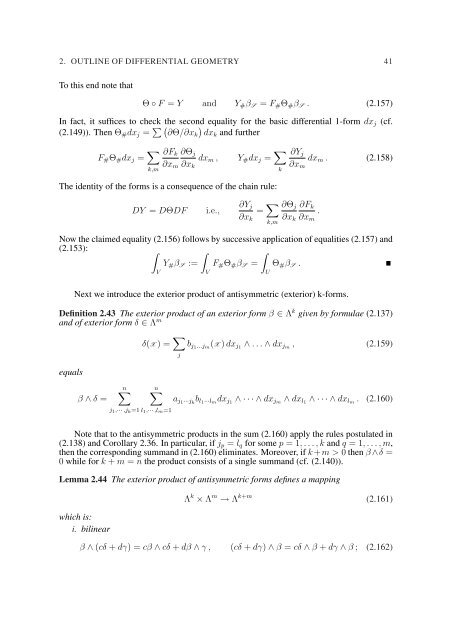EQUATIONS OF ELASTIC HYPERSURFACES
EQUATIONS OF ELASTIC HYPERSURFACES
EQUATIONS OF ELASTIC HYPERSURFACES
You also want an ePaper? Increase the reach of your titles
YUMPU automatically turns print PDFs into web optimized ePapers that Google loves.
2. OUTLINE <strong>OF</strong> DIFFERENTIAL GEOMETRY 41<br />
To this end note that<br />
Θ ◦ F = Y and Y # β S = F # Θ # β S . (2.157)<br />
In fact, it suffices to check the second equality for the basic differential 1-form dx j (cf.<br />
(2.149)). Then Θ # dx j = ∑ ( ∂Θ/∂x k<br />
)<br />
dxk and further<br />
F # Θ # dx j = ∑ k,m<br />
∂F k<br />
∂x m<br />
∂Θ j<br />
∂x k<br />
dx m ,<br />
Y # dx j = ∑ k<br />
∂Y j<br />
∂x m<br />
dx m . (2.158)<br />
The identity of the forms is a consequence of the chain rule:<br />
DY = DΘDF<br />
i.e.,<br />
∂Y j<br />
∂x k<br />
= ∑ k,m<br />
∂Θ j<br />
∂x k<br />
∂F k<br />
∂x m<br />
.<br />
Now the claimed equality (2.156) follows by successive application of equalities (2.157) and<br />
(2.153): ∫ ∫<br />
∫<br />
Y # β S := F # Θ # β S = Θ # β S .<br />
V<br />
V<br />
Next we introduce the exterior product of antisymmetric (exterior) k-forms.<br />
Definition 2.43 The exterior product of an exterior form β ∈ Λ k given by formulae (2.137)<br />
and of exterior form δ ∈ Λ m<br />
U<br />
δ(X ) = ∑ j<br />
b j1 ...j m (X ) dx j1 ∧ . . . ∧ dx jm , (2.159)<br />
equals<br />
β ∧ δ =<br />
n∑ n∑<br />
a j1···j k<br />
b l1···l m<br />
dx j1 ∧ · · · ∧ dx jm ∧ dx l1 ∧ · · · ∧ dx lm . (2.160)<br />
j 1 ,··· ,j k =1 l 1 ,··· ,l m =1<br />
Note that to the antisymmetric products in the sum (2.160) apply the rules postulated in<br />
(2.138) and Corollary 2.36. In particular, if j p = l q for some p = 1, . . . , k and q = 1, . . . , m,<br />
then the corresponding summand in (2.160) eliminates. Moreover, if k +m > 0 then β ∧δ =<br />
0 while for k + m = n the product consists of a single summand (cf. (2.140)).<br />
Lemma 2.44 The exterior product of antisymmetric forms defines a mapping<br />
which is:<br />
i. bilinear<br />
Λ k × Λ m → Λ k+m (2.161)<br />
β ∧ (cδ + dγ) = cβ ∧ cδ + dβ ∧ γ , (cδ + dγ) ∧ β = cδ ∧ β + dγ ∧ β ; (2.162)

















